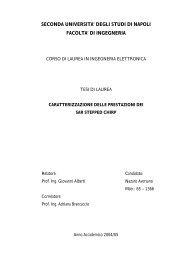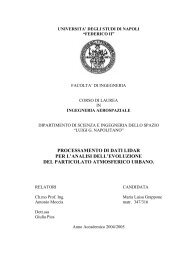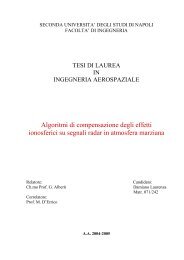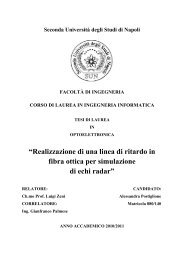Intersatellite link for Earth Observation Satellites ... - CO.RI.STA
Intersatellite link for Earth Observation Satellites ... - CO.RI.STA
Intersatellite link for Earth Observation Satellites ... - CO.RI.STA
Create successful ePaper yourself
Turn your PDF publications into a flip-book with our unique Google optimized e-Paper software.
- Silicon avalanche photodiode (APDs) with highly optimised excess noise factor allow maximum<br />
communication per<strong>for</strong>mance with the very low-level received signal (135 photons/bit direct detection at 810nm,<br />
BER=10 -6 and 60Mbit/s);<br />
It has to be underlined that SILEX “has been dimensioned using the limited laser diode power available at the end of<br />
the 1980's, namely 60mW average power at 830nm” [Lutz]. Thus, SILEX appears hardly an attractive alternative to<br />
a RF terminal of comparable transmission capability. Nevertheless SILEX programme shows high reliability with a<br />
life time higher than 100000 hours [Planche].<br />
The success of SILEX demonstrates also that <strong>for</strong> low earth and geostationary orbits (LEO & GEO) optical <strong>link</strong>s the<br />
semiconductor lasers which can support simple current modulation up to 600Mbp, with wavelength range<br />
compatible with silicon detectors, adapted to fast acquisition, high electrical/power efficiency (about 30%),<br />
compatibility with multiplexing thanks to available wavelengths, are suitable in order to achieve maximum data<br />
rates, channel capacity with relatively high average to peak power ratio [Biswas].<br />
Their main drawbacks are the limited available output power (about 0.4W) <strong>for</strong> communication transmitter and the<br />
diverging astigmatic beam pattern which requires an anamorphoser. For this reason <strong>for</strong> deep space communications<br />
solid state Q-switched lasers with high peak power and low duty cycle, are ideally suited in order to maximise the<br />
photon efficiency, to minimize the average to peak power ratios, to hold the average power constant. Hence today<br />
the transmitter typically used in a free-space laser communications system are either semiconductor laser diodes,<br />
solid state lasers and recently fiber amplifiers/lasers.<br />
For free space communication system, the dimension of a terminal are driven by the aperture of the telescope<br />
required to collect enough photons to achieve a specified BER at a given data rate, received power and <strong>link</strong><br />
distance. The sensitivity of the receiver used is, there<strong>for</strong>e, an essential driven <strong>for</strong> the telescope size and, hence the<br />
terminal dimensions. For an instrument of the size of an optical terminal the mass is quite well related to the<br />
dimensions. Taking into account the power consumption, it is also advantageous to select the design that offers the<br />
highest receiver sensitivity because the required transmit power is kept lower.<br />
Many works [Bondurant, Rochat, Shimer, Chan, Cryan] demonstrate that <strong>for</strong> a given <strong>link</strong> distance the sensitivity of<br />
a coherent terminal can be used to reduce the telescope size, the overall dimension and the mass of the terminal.<br />
Nevertheless the implementation loss (mechanical/thermal stability requirements) <strong>for</strong> coherent systems and the<br />
higher complexity negates theoretical advantage while direct detection in the space is easier and lower risk based on<br />
current technology thanks to terrestrial heritage.<br />
Going into details, with a suitable low noise optically preamplified direct detection receiver such as an Erbium<br />
doped fiber amplifier (EDFA), many of the lost dBs can be recovered.<br />
EDFA is used to boost the intensity of optical signals being carried through the fiber optic communication system.<br />
The optical fiber is doped with rare earth element erbium so that the glass fiber can absorb light at one frequency<br />
and emit light at another frequency. The external semiconductor laser couples light into the fiber at infrared<br />
wavelengths of either 980 or 1480nm. This action excites the erbium atoms. Additional optical signals at<br />
wavelengths between 1530 and 1620nm enter the fiber and stimulate the excited erbium atoms to emit photons at the<br />
same wavelength as the incoming signal. This action amplifies a weak optical signal to higher power.<br />
Chan underlines how though EDFA and heterodyne detection have similar per<strong>for</strong>mance, the EDFA pre-amplified<br />
direct detection receiver lends itself to much easier implementation and has to be favourite <strong>for</strong> optical satellite<br />
communication systems [Chan]. Also <strong>for</strong> Cryan, owing to of the reduced complexity and good potential sensitivity,<br />
direct detection is the preferred technology <strong>for</strong> optical satellite communications [Cryan]. However about EDFA,<br />
most of the commercial available fibers are extremely sensitive to the radiation environment in space: radiation<br />
damage can increase the transmission loss significantly and, thus, degrade the fiber amplifier significantly. Due to<br />
the complex spectrum of the radiation environment in space and the low dose rate, it is very difficult to per<strong>for</strong>m<br />
fully representative space radiation test on ground. Although there are some technological solutions to reduce losses<br />
of the fibers in space [Rochat], the fiber amplifiers remain an extremely sensitive devices in space environment.<br />
8<br />
American Institute of Aeronautics and Astronautics








